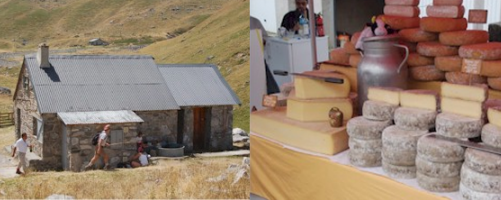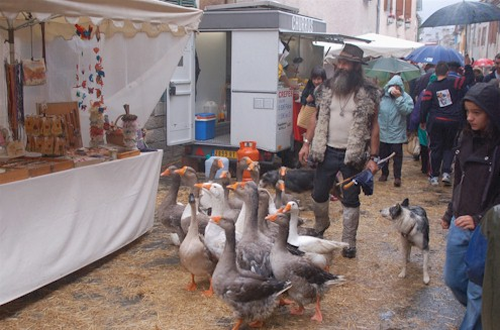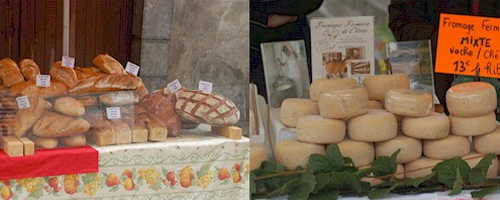Cheese Stories - Wine and Cheese in France
Posted by Bob Eifling on 3rd Apr 2016
PUBLISHER'S NOTE: Bob Eifling, 'our man in France' residing in a small French town where few, if any speaks English. He wants to learn the language and understand the culture. He arrived the first week of October, 2007. Bob is seeking out the local cheese and wine makers. Below is Bob's second installment.
-Steve Shapson

The Foire au Fromage (Cheese Festival) was held the second weekend in October here in Laruns. It was a much-anticipated event and despite the rain attendance was normal. Cheeses from several regions of France were presented, Comte, Cantel, Brie and the list goes on, but the star of the show was the regional cheeses, chevre, brebis (sheep), vache (cow) and mélange, a mixture of brebis and vache, chevre and vache, or brebis and chevre.
The Ossau Valley produces several varieties of cheeses, Ossau, Iraty, Brebis, Pyrenees, but the star of the show, and the one that gives fame to the region, are those from brebis, pronounced, “bro-be.” The cheese is a raw sheep’s milk, slightly pressed, and aged a minimum of three to five months. Brebis cheeses are 45 to 50% fat, slightly acidic in taste, with a smooth to brittle texture, depending on age, with a natural rind. When the cheese is young it has a smooth nutty taste, but as it ages it becomes brittle. Brebis is normally used as a table cheese, but when aged can be used effectively in cooking. Based on today’s dollar, pure brebis cheese cost about $10 per pound while the mélange is about $11 and vache $5.
When considering a wine paring, the locals will use a Jurançon. Jurançon is an AOC wine produced in the area just south of Pau, the capital of the Béarn Region, about twenty miles north of Laruns where I am located. It is produced from the Gros Manseng, Petit Manseng and Courbu grapes. If you can’t get your hands on a Jurançon Sec, a white Grave will also work nicely.
Jurançon wines are all white and can also be sweet, similar in taste to Sauternes, at a fraction of the cost, but with equal quality. The sweet wines are very well suited for consumptions with another local specialty, fois gras. Fois gras in the region is produced from both duck and geese.
Other wines produced in the region are Béarn Rouge and Béarn Rose produced from Tannat, Manseng Noir and Cabernet Franc grapes. If you ever wondered where Béarnise Sauce originated, this is the place. Both Béarn and Jurançon are AOC wines.
Much of the cheese made in the Ossau Valley is produced in the mountains while the sheep are grazing in the late spring and summer months. The berger (bergère if female), shepherd, will stay with the sheep for up to three months without a break. During that time the berger will live in the mountain huts, bergerie, and make the cheese on the premises.
After visiting a bergerie I can tell you it is a sparse life at an altitude of over 1 mile. If you are looking for solitude, this could be the life for you.
Another type of sheep cheese produced in the area is Ossau-Iraty. It is also a pure brebis, but it is distinguished by being made primarily from milk from the Manech ewes, recognizable by their black head.
Iraty is a mild and creamy cheese when young and becomes firmer as it ages and can have small holes similar to Pyrenees cheese. It is buttery in the mouth with flavors of nuts, fruit and herbs.
Now back to the Foire au Fromage. In addition to the cheeses, the festival is a mélange of local artistines featuring woodworkers, pottery makers, basket weavers, cake makers, sausage of every type, clothes and of course, a beret or two. This is the Basque region you know.
In closing this issue I’m including a few of the attractions from the festival.
 The Geese Herder, pictured here, was a hit of the sideshows. When he moved the geese moved. When he stopped the geese stopped. As he would visit with the locals and exhibitors, his three dogs would keep the geese in order.He wandered throughout the festival all day and the geese never left his side. I’m not sure if this is the geese only job, but if not they are very well adapted to being around crowds of people and following orders.
The Geese Herder, pictured here, was a hit of the sideshows. When he moved the geese moved. When he stopped the geese stopped. As he would visit with the locals and exhibitors, his three dogs would keep the geese in order.He wandered throughout the festival all day and the geese never left his side. I’m not sure if this is the geese only job, but if not they are very well adapted to being around crowds of people and following orders.

It was obvious that the basket weaver had been doing this for a long time and he dressed the part of a showman. I’m sorry to say I failed to buy one of his baskets, but it gives me a good reason to return to Laruns next year for the festival.





